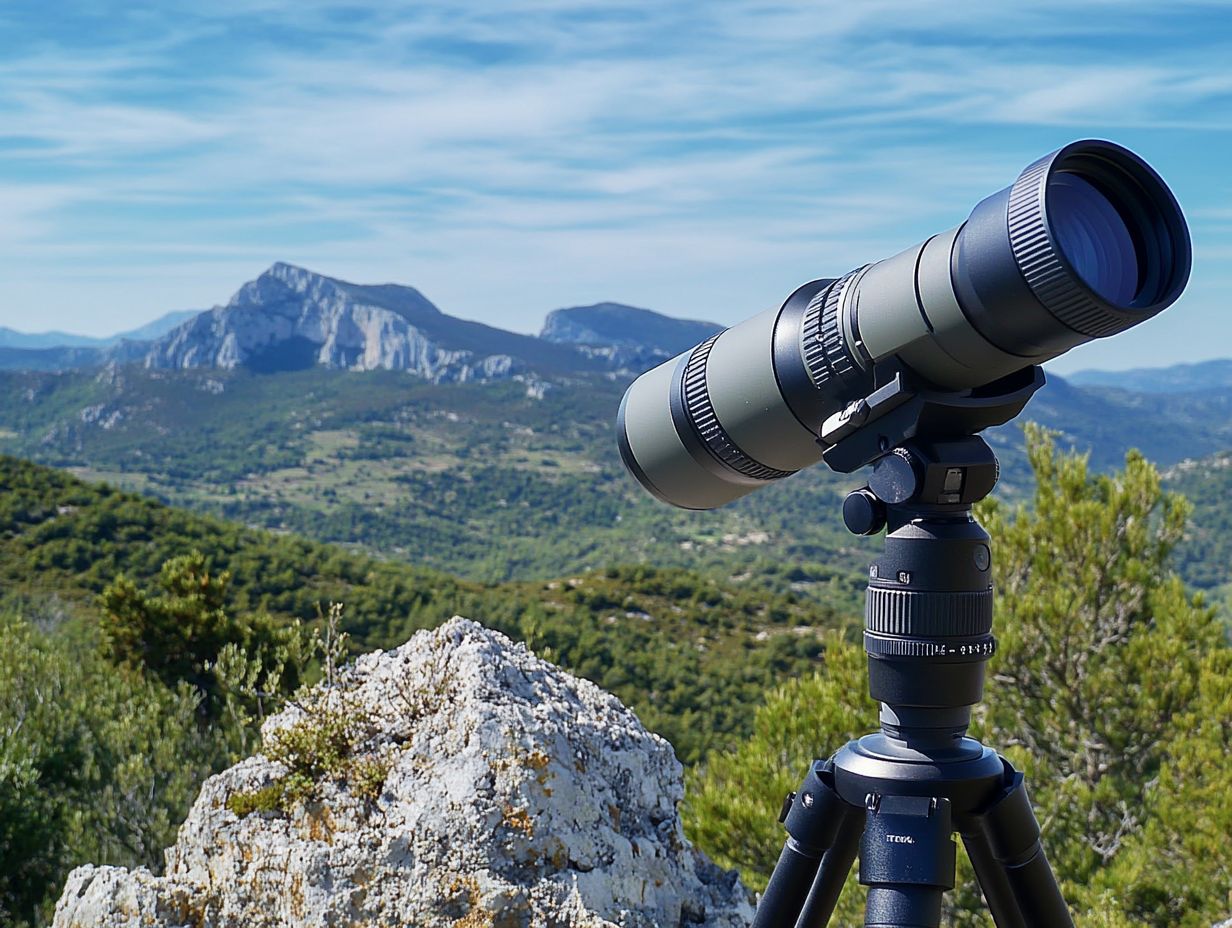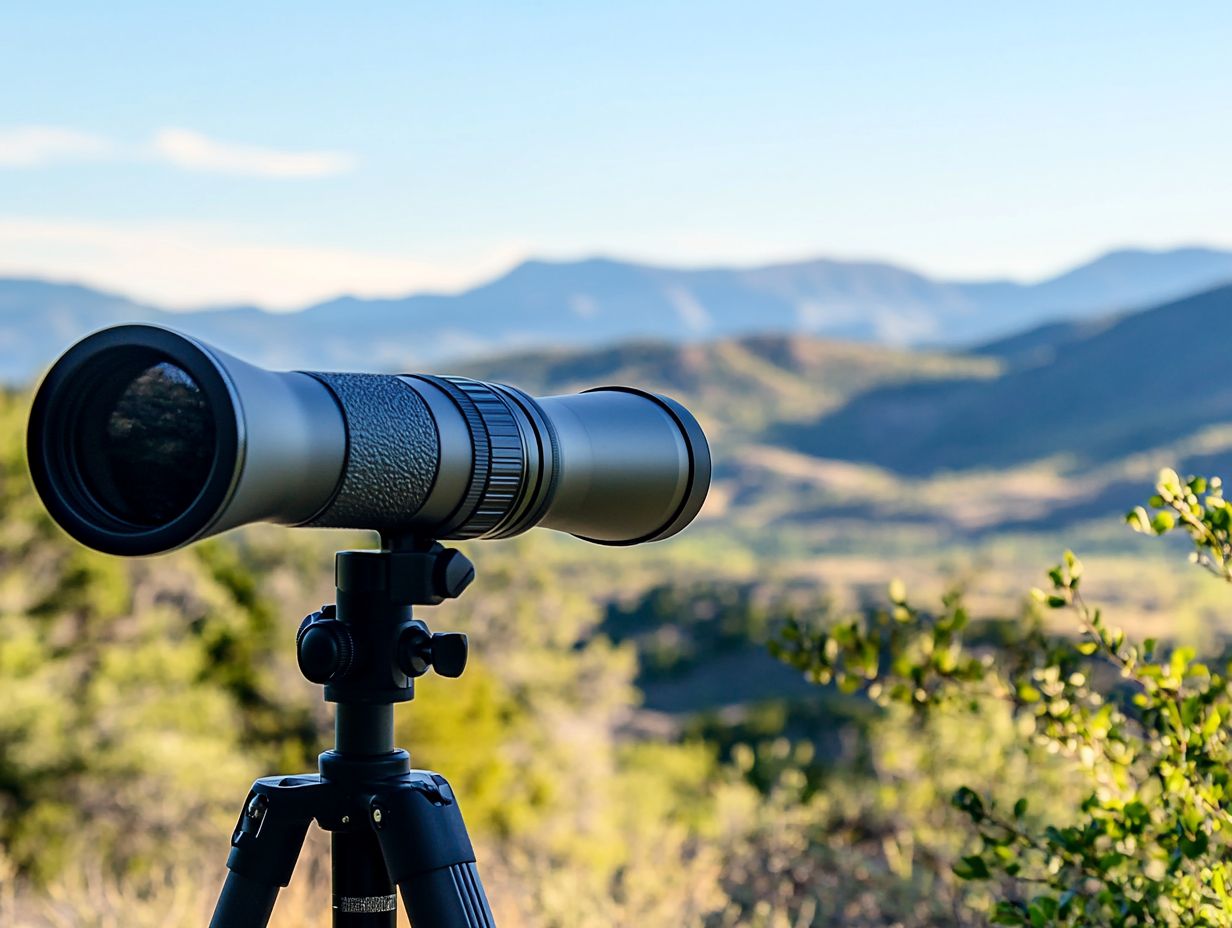Spotting Scope Optics: Understanding the Basics
If you’re an outdoor enthusiast, bird watcher, or wildlife observer, a spotting scope might just become your most treasured companion for getting up close and personal with distant subjects.
Get ready to explore the essentials of spotting scopes! This guide will cover the various types such as straight versus angled and compact versus full-size and highlight crucial optical features to consider, including magnification and lens coatings.
By the end, you’ll be ready to choose your perfect spotting scope and elevate your adventures!
Contents
- Key Takeaways:
- What is a Spotting Scope?
- Why Optics Matter
- Types of Spotting Scopes
- Key Optical Features to Consider
- Prism Types
- Understanding Lens Coatings
- Choosing the Right Spotting Scope for Your Needs
- Frequently Asked Questions
- What is a spotting scope and why is understanding its optics important?
- What are the different types of lenses used in spotting scopes?
- What do the numbers on a spotting scope mean?
- What is the difference between straight and angled spotting scopes?
- How do I care for and maintain my spotting scope optics?
- Why is a good quality tripod necessary for using a spotting scope?
Key Takeaways:

- A spotting scope is a portable and powerful optical device used for long-distance viewing.
- The quality of optics greatly affects the performance and clarity of a spotting scope.
- When choosing a spotting scope, consider factors such as type, optical features, and lens coatings to find the best fit for your needs.
What is a Spotting Scope?
A spotting scope is your compact yet powerful companion for outdoor pursuits like bird watching, wildlife observation, and target shooting. To fully appreciate its capabilities, it’s helpful to grasp the technology behind spotting scopes. With its impressive magnification range and superior lens quality, this device enables you to observe distant subjects with striking clarity.
Thanks to advancements in optical technology, spotting scopes come equipped with features that enhance image quality. An optical tube sharpens your view, while the objective lens size determines how much light is captured. Whether you’re tracking shorebirds in the Great Smoky Mountains or refining your hunting optics, understanding spotting scope selection factors transforms your outdoor experience, revealing nature’s wonders in stunning detail!
Spotting scopes provide superior magnification, making them perfect for observing distant wildlife or the intricate details of bird plumage. Their single-barrel construction ensures a more stable image compared to traditional monoculars, and understanding the evolution of spotting scopes can enhance your appreciation of these tools, delivering crisp, clear visuals even at higher magnifications.
Many spotting scopes feature adjustable eyepieces, allowing you to tailor your viewing experience, while their durable, waterproof designs guarantee reliability in various weather conditions. For avid bird watchers, spotting scopes for kids open up a world of ornithological wonders, turning each outdoor excursion into an extraordinary adventure.
Why Optics Matter
The quality of optics in any observing device, including spotting scopes, profoundly influences your wildlife observation and bird watching experience. High-quality lenses and special coatings applied to the lenses reduce glare and improve light transmission, allowing you to observe various bird species and wildlife with precision. This is especially important for enthusiasts like you, exploring the rich diversity of wildlife in regions such as the Great Smoky Mountains.
When selecting a spotting scope, pay attention to features like multi-coating and phase-corrected prisms. Multi-coated lenses minimize glare and improve light transmission, ensuring you enjoy brighter views during those magical early mornings or late afternoons when wildlife is most active. For more detailed insights, check out the top features to look for in a spotting scope.
For example, optics featuring fluorite glass can vastly enhance color accuracy and sharpness. This technological leap is a game-changer for bird watchers eager to spot subtle differences in plumage.
By investing in scopes with superior lenses and coatings, you open the door to remarkable detail and contrast, elevating your nature-watching experiences be it a majestic eagle soaring overhead or a delicate hummingbird flitting among wildflowers.
Types of Spotting Scopes
Spotting scopes are available in a range of designs, primarily divided into straight and angled constructions. Each type is tailored to suit different outdoor activities and preferences. Understanding the field of view in spotting scopes can help you make an informed decision between compact and full-size models, further enhancing their versatility for bird watching, hunting, and even astronomical observations.
When you use a tripod properly, you ll achieve greater stability, resulting in clearer images no matter which scope design you choose.
Straight vs. Angled
When you’re deciding between straight and angled spotting scopes, it’s crucial to reflect on how each design influences usability and comfort during your wildlife observations.
For instance, when you re birdwatching, a straight scope may suit you better for tracking swift, dynamic birds in flight. It offers a more natural line of sight, allowing you to enjoy the moment without constantly adjusting the eyepiece.
On the other hand, if you plan to observe from a fixed position for an extended period like settling in at a scenic vantage point in a nature reserve an angled scope can be a game changer. Its design enhances comfort, transforming your overall experience into something truly enjoyable.
Each style has its advantages. By considering your activity’s specific needs, you’ll be better equipped to make a choice that perfectly balances ease of use with the sheer joy of connecting with the natural world.
Compact vs. Full-size

Choosing between compact and full-size spotting scopes requires weighing the trade-offs between portability and how well you can see. Compact spotting scopes are lightweight and easy to carry, making them perfect for hiking and outdoor pursuits. In contrast, full-size scopes typically feature larger optical tubes that enhance image quality and brightness.
To determine the best fit for your needs, consider your specific use cases. If you re a birdwatcher navigating rugged terrain, the convenience of a compact model will lighten your load during long treks while still offering satisfactory clarity. Conversely, if you find yourself engaged in stationary activities like target shooting or wildlife observation from a fixed vantage point, full-size options provide superior magnification and detail, allowing you to appreciate distant subjects.
By evaluating your surroundings and intended application, choose the perfect scope to elevate your outdoor adventures!
Key Optical Features to Consider
When choosing a spotting scope, you’ll find that several optical features are pivotal in determining its effectiveness for pursuits such as birdwatching and understanding spotting scope specifications for target shooting.
Key elements to consider include magnification levels, objective lens size, and lens quality all of which significantly influence how well you can see and your overall viewing experience.
Magnification and Objective Lens Size
Magnification is one of the most critical specifications for spotting scopes, determining how closely you can observe distant subjects. The size of the objective lens is equally vital, as it plays a significant role in gathering light and enhancing how well you can see.
A spotting scope with high zoom magnification allows you, as an avid birdwatcher, to identify various bird species from impressive distances.
To achieve the optimal viewing experience, find the right balance between magnification and objective lens size. A larger objective lens, typically 60mm or more, captures more light, making it ideal for low-light conditions like dawn or dusk prime times for birdwatching.
For example, pairing a magnification of 20x to 30x with a 60mm objective lens can deliver exceptional clarity while maintaining a wide field of view, crucial for tracking the swift movements of wildlife. In open areas where subjects may be farther away, consider higher magnifications, such as 40x, along with larger lenses that gather sufficient light to ensure clear images without sacrificing detail.
Explore our collection of scopes today and find the perfect one for your next adventure!
Prism Types
The type of prism you choose for your spotting scope plays a crucial role in how well you can see. You ll encounter two common types: Porro prisms and roof prisms. Each brings its own advantages for image clarity and portability.
Porro prisms are celebrated for their exceptional depth perception and wide field of view. These features make them ideal for wildlife observation, where detail and perspective are key. However, they tend to be bulkier compared to roof prisms.
On the other hand, roof prisms offer a streamlined and compact design. They are perfect for those seeking portability and ease during outdoor adventures.
Your choice between these prism types influences not only the weight and size of your spotting scope but also affects image clarity under various lighting conditions. Ultimately, this choice can significantly enhance your experience, whether you re an enthusiast or a professional in the field.
Understanding Lens Coatings
Lens coatings play a vital role in defining the quality of images produced by spotting scopes. They influence aspects such as light transmission and glare reduction, directly impacting your viewing experience.
By understanding these coatings, you can elevate your outdoor activities, ensuring that you enjoy crystal-clear views while bird watching or observing wildlife.
Types of Coatings and Their Benefits

Several types of lens coatings are available for spotting scopes. Anti-reflective coatings significantly enhance image clarity and brightness during wildlife observation. These coatings reduce glare and elevate your viewing experience, making them essential for birdwatchers and outdoor enthusiasts.
In addition to anti-reflective options, you ll find hydrophobic and scratch-resistant treatments that offer substantial advantages. Hydrophobic coatings repel water, allowing for quick cleaning and ensuring a clear view even in challenging weather especially valuable when observing migratory birds.
Scratch-resistant layers extend the lifespan of your lenses, preserving clarity over time. Some spotting scopes even have UV coatings that shield against harmful rays, enhancing your comfort during longer viewing sessions.
These coatings truly elevate your experience, allowing you to enjoy pristine visuals without interruptions, no matter the environment.
Choosing the Right Spotting Scope for Your Needs
Selecting the perfect spotting scope requires careful consideration of several factors, such as your intended outdoor activities, budget, and specific needs for wildlife observation or bird watching.
Familiarizing yourself with reputable brands enables you to make informed purchasing decisions that align with your requirements.
Factors to Consider and Recommended Brands
When evaluating factors for selecting a spotting scope, consider image clarity, durability, and weight. Keep your specific outdoor activities in mind whether it s birdwatching or hunting. Trustworthy brands like Vortex, Swarovski, and Leupold have built their reputations on quality and performance.
Image clarity is paramount; it directly affects how well you can see details, especially at longer distances. Durability ensures your scope can handle harsh weather conditions or rough treatment during adventures. Weight impacts portability and ease of use during extended viewing sessions.
If you’re immersing yourself in birdwatching, you might lean toward a lightweight model. Conversely, hunting may call for a more robust design. Each of these elements contributes to your overall experience, making thoughtful consideration essential for achieving optimal satisfaction.
Frequently Asked Questions
What is a spotting scope and why is understanding its optics important?
A spotting scope is a portable, high-magnification telescope used for viewing distant objects. Understanding spotting scopes and their optics is crucial for achieving maximum clarity and accuracy when observing targets or wildlife.
What are the different types of lenses used in spotting scopes?

The two main types of lenses used in spotting scopes are the objective lens and the eyepiece lens.
The objective lens is the large lens at the front that gathers light and creates a magnified image, while the eyepiece lens allows for further magnification and focusing.
What do the numbers on a spotting scope mean?
The numbers on a spotting scope refer to its magnification power and objective lens size. For example, a spotting scope with the numbers 20-60×80 means it has a magnification range of 20x to 60x and an 80mm objective lens.
What is the difference between straight and angled spotting scopes?
Straight spotting scopes have a straight barrel. Angled spotting scopes have a 45-degree angle in the barrel.
Angled scopes are more comfortable for extended viewing periods and allow for easier sharing among multiple viewers.
How do I care for and maintain my spotting scope optics?
Keep your spotting scope in top shape for those breathtaking moments! Clean your spotting scope’s lenses with a soft, lint-free cloth and lens cleaner.
Avoid touching the lenses with your fingers and store the scope in a protective case when not in use.
Why is a good quality tripod necessary for using a spotting scope?
Using a good quality tripod is essential for stability and steadiness when using a spotting scope. It reduces the risk of blurry images and allows for easier tracking of moving targets.
Ready to enhance your outdoor experience? Check out our top-rated spotting scopes today!






